C’è una storia che non si racconta con le parole, ma con i materiali. E quindi ci sono materiali che ripercorrono i secoli e i millenni per ancorarsi a radici remotissime e insieme trasmettere un’energia che non può che indirizzarsi verso il futuro per tramandare esperienze eterne. Questi materiali parlano di una potenza come possibilità o facoltà che promette un’evoluzione futura. Si pensi che in embriologia il termine “potenza” indica la possibilità (e non capacità) dell’uovo o dell’embrione di evolversi in qualcosa di più complesso.
Wolfgang Laib è un artista tedesco – nato a Metzingen nel 1950, ora vive e lavora tra Hochdorf (Germania), New York e India – che da anni crea opere che parlano proprio della dimensione in potenza dei materiali naturali.
La sua prima opera nasce nei primi anni Settanta, quando realizza a partire da una grande roccia nera un Brahmanda, scultura ovale ispirata al mito dell’uovo cosmico di Brahma, simbolo della nascita dell’universo. Tali sculture saranno una costante della sua produzione fino ad oggi. Nel 1975 realizza invece Milkstone, costituita da una lastra di marmo bianco dalla superficie lievemente concava in cui è versato del latte. I due materiali si mescolano a livello cromatico e ognuno aggiunge all’altro una sua qualità fisica: il latte permette al marmo di vibrare al vento; il marmo concede al latte un’eternità per lui nemmeno ipotizzabile. Notiamo che l’uovo della prima opera e il latte della seconda parlano proprio di questa potenza: nell’uovo è lampante, nel latte è insita nella sua capacità di nutrire le nuove forme di vita animale. E il marmo? Non è anch’esso scultura in potenza, come insegnerebbe Michelangelo?
Nel 1977 Laib comincia ad utilizzare un altro materiale che rivedremo spesso negli anni a venire e amplificarsi a livello luminoso. Crea un rettangolo temporaneo di luce sul pavimento, realizzato attraverso polline personalmente raccolto in un meticoloso lavoro di ricerca, attesa, selezione, filtraggio. Nella sua carriera ha realizzato più volte in gallerie e musei rettangoli o quadrati di gialli sempre diversi che diventano fonti luminose, monocromi fatti senza pittura, finestre di luce che cambiano intensità a seconda della sua provenienza: tarassaco, pino, nocciolo, ranuncolo o dente di leone. Si tratta in questo caso della potenza autentica, una fertilità che da millenni è alla base della biodiversità, del mondo stesso: il quadrato di polline diventa simbolo radioso di concitazione vitale, è il latente principio vitale di milioni di fiori e piante, quel giallo contiene celata la vita, come l’azzurro del cielo preserva e maschera l’infinito dell’universo.
Quando si parla di potenza si tratta allora anche di binomi: tra il moto e la quiete, tra il materiale e l’immateriale, tra il durevole e l’effimero, l’equilibrio e la trasformazione. È l’aristotelico duello tra potenza e atto, tra qualcosa che promette e il destino già compiuto. Laib si focalizza sul limbo intermedio, lo spazio sospeso in cui si gioca la vita.
Semplicità, purezza e calma trapelano nelle sue opere, che oltre a marmo, latte e polline negli anni verranno realizzate con cera d’api, riso, occasionalmente metallo: per lo più materiali perituri ed effimeri, però alla base della vita. Il riso dal 1983 assume importanza consistente nel suo repertorio di materiali dopo un viaggio in India e anch’esso, in quanto seme e fonte d’energia con vari riferimenti simbolici, indica una potenza. Il riso viene esposto in piccoli cumuli disposti ordinatamente all’interno di una stanza, spesso ricoprendo buona parte del pavimento del luogo. Oppure diventa la base su cui galleggiano barche d’ottone in miniatura (Passageway) – simboli di un viaggio spirituale verso una realtà non esclusivamente tangibile, ma anche emotiva, mistica – o su cui sono depositate piccole case di marmo (Rice Houses). Lo stesso vale per opere come le ziggurat realizzate in cera d’api, anch’esse riferite ad un luogo spirituale e volte al mistero della vita. In questo notiamo dunque la forte influenza della filosofia orientale sulla sua pratica, che si manifesta nella scelta di pochi materiali e nel rigore di dedizione all’arte. Non a caso la sua mostra alla galleria Thaddaeus Ropac di Parigi realizzata nel 2017 aveva come titolo The Beginning of Something Else, come a esplicitare che ogni materiale, ogni forma, ogni disposizione richiama qualcos’altro, all’interno del trionfo della natura, o nella domanda dell’esistenza, fino al mistero dello spirito e alla sfera della devozione. Quest’ultima si manifesta in una dimensione ritualistica di Wolfgang Laib nei confronti del lavoro: la scelta del polline avviene in anni di paziente ricerca, la disposizione di questo o del riso per creare le opere prevede una concentrazione e un rigore assoluti, la simbologia a cui rimandano le materie scelte è sintomo di una ricerca ampia e prolungata. Sono costanti anche i paradigmi del suo vocabolario formale, che tende al minimalismo e si fonda su rettangolo, cerchio, piramide e cono, che talvolta con leggeri interventi vengono trasformati in motivi stilizzati, archetipici e auratici di casa, montagna, barca o scale.
Allora quello di Laib è un lavoro che ha a che fare con un processo antico e universale, che collega il privato al cosmo, mescola l’intimo con un disegno superiore su cui invita a riflettere o con cui chiede di relazionarsi. La cera d’api che lui utilizza parla in qualche modo anche di questo: il risultato di un mondo tacito e scrupoloso come quello delle laboriose api, che producono una sostanza conosciuta e apprezzata da millenni, che appare oggi come era allora e che conserva in sé il fervore della metamorfosi. Con essa ha realizzato sculture a forma di barca, grandi ziggurat (come Without Beginning and Without End, 2005), o piccoli archetipi di abitazioni. Ha creato anche vere e proprie architetture di cera d’api: la prima era una stanza esposta alla collettiva Zeitlos all’Hamburger Bahnhof di Berlino; ma ricordiamo anche quella permanente alla Philipps Collections (Where have you gone – where are you going?, 2013) e un ambiente più ampio a tetti spioventi a La Ribaute, ex fabbrica di seta ora studio dell’artista tedesco Anselm Kiefer (From the Known to the Unknown – To Where Is Your Oracle Leading You, 2014). In questi lavori il micro si fonde con il macro, riconfigurando la nostra presenza nell’universo.
Per concludere, possiamo considerare due ultimi aspetti del lavoro di Laib: la ricerca della luce nei materiali che da essa dipendono e l’atemporalità degli stessi. Si pensi al polline cosparso sui fiori, alla cera prodotta dalle api, ai chicchi di riso nati dalle relative piante, e poi ai colori, giallo, ocra, bianco, e al fuoco e la cenere di altri lavori ancora. Tutto è volto alla luce: con cautela e rigore ogni opera rappresenta la tensione verso una luminosità terrestre, universale, mistica.
Inoltre, sono tutti materiali propri della storia del mondo, più che dell’uomo: sono nati prima loro di noi. E allora a contatto con questi viene in mente una frase di Umberto Eco: “Chi non legge, a 70 anni avrà vissuto una sola vita: la propria. Chi legge avrà vissuto 5000 anni: c’era quando Caino uccise Abele, quando Renzo sposò Lucia, quando Leopardi ammirava l’infinito… perché la lettura è un’immortalità all’indietro”. Chi è con le opere di Wolfgang Laib c’era prima di tutto questo.
Wolfgang Laib ha rappresentato il Padiglione tedesco alla Biennale di Venezia del 1982 con Hanne Darboven e Gotthard Graubner e nello stesso anno ha partecipato a Documenta 7, ritornandoci nel 1987 e vincendo l’Arnold Bode Price. Ritorna a Venezia nel 1997 e 1999, nel Padiglione Centrale della Biennale d’Arte.
Nel 2015 gli viene consegnato a Tokyo il Praemium Imperiale, premio giapponese assegnato per contributi allo sviluppo, alla promozione e al progresso delle arti.
Sue opere sono presenti in numerosi musei internazionali, tra cui Centre Georges Pompidou di Parigi, The Museum of Contemporary Art di Los Angeles, The Museum of Modern Art di New York.
There is a story that is not told with words, but with materials. And therefore, there are materials that retrace centuries and millennia to reach ancient roots and transmit an energy that can only be addressed at the future, to pass on timeless experiences. These materials speak of potential as the possibility or faculty allowing a future evolution. It should be thought that in embryology the term “potential” specifies the possibility (and not the capacity) for the egg or embryo to evolve into something more complex.
Wolfgang Laib is a German artist – born in Metzingen in 1950, currently living and working between Hochdorf (Germany), New York and India – who for years has been creating works that speak precisely of the potential of natural materials.
His first work was realized during the early 1970s, when he creates starting from a huge black boulder a Brahmanda, an oval sculpture inspired by the myth of the cosmic egg of Brahma, symbol of the birth of the universe. Such sculptures will be a constant of his production until today. In 1975 he creates Milkstone, realized from a white marble slab, with a slightly concave surface where milk is poured. The two materials mix on a chromatic level and each one confers the other its physical property: the milk allows the marble to vibrate with the wind, the marble confers the milk an eternity not even conceivable before. We note that the egg of the first work and the milk of the second one speaks precisely of this potential: in the egg, it is glaring, in the milk it is inherent in its capacity of nourishing new life forms. And what about the marble? Is not marble a potential sculpture, as Michelangelo would teach us?
In 1977 Laib begins employing another material we would often see again in the following years, amplifying its light. He creates a temporary light rectangle on the floor, formed with pollen personally collected after a meticulous research, selection and filtering. During his career he has used several times, in galleries and museums, rectangles or squares of different shades of yellow, which become light sources, monochromes without painting, windows of light changing intensity following the source of the light: dandelion, pine, hazelnut, buttercup. In this case, it is about authentic potential, a fertility that for millennia has been the root of biodiversity, of the world itself: the pollen square becomes a radiant symbol of vital excitement, it is the hidden vital principle of millions of flowers and plants. That yellow hides life, just like the azure sky preserves and hides the infinite universe.
When we talk about potential, we are also talking about a dichotomy: between movement and stillness, material and immaterial, lasting and ephemeral, equilibrium and transformation. The Aristotelian duel between potential and action, between something promising and a destiny which is already written. Laib focalizes on the middle Limbo, the suspended space where life is at play.
Simplicity, purity and quietness transpire through his works, that during the years would be realized, other than with marble, milk and pollen, with beeswax, rice and occasionally, metal: mostly perishable and ephemeral materials, at the same time the basis of life. Starting in 1983 rice gains a considerable importance in his repertoire after a voyage to India, and even rice, as seed and source of energy with several symbolic references, points towards a potential. Rice is displayed in little piles orderly scattered inside a room, often covering most of the floor. Or it can become the base on which miniature brass boats float (Passageway) – symbols of a spiritual journey towards a non-exclusively-tangible reality, but also emotive, mystic – or where little marble houses are placed (Rice Houses). The same goes for works such as the ziggurats realized in beeswax, equally referencing a spiritual place and aimed at the mystery of life. We can therefore note the strong influence of oriental philosophy in his practice, manifesting in the choice of few materials and in the rigorous dedication towards art. It is not by chance that his exhibition at the Thaddaeus Ropac gallery in Paris, realized in 2017, was titled The Beginning of Something Else, as to clarify that every material, every shape, every disposition references something else, inside the triumph of nature, or in the question of existence, reaching the mystery of spirit and the dimension of devotion. The latter is manifested in a ritualistic dimension of Wolfgang Laib towards the work: the choice of pollen takes years of patient research, the disposition of the right variety of rice to create the piece requires absolute concentration and rigor, the symbology referenced by the chosen materials is the result of broad and extended research. The paradigms of his formal vocabulary are constant features as well, tending to minimalism, based on the rectangle, circle, pyramid and cone: figures that sometimes are transformed, with minimal interventions, into stylized, archetypal and auratic motifs of house, mountain, boat or stairs.
Then, Laib’s work has much to do with an ancient and universal process, linking the private with the cosmos, mixing the intimate with a master plan we are invited to ponder on and relate with. The beeswax he employs speaks in some way of this as well: the result of an implicit and meticulous world such as the world of the hard-working bees, which produce a substance known and appreciated for millennia, appearing today as it was then and preserving the fervor of metamorphosis. With it, he realized sculptures shaped like boats, large ziggurats (Without Beginning and Without End, 2005), or small architypes of houses. He also created real architectures made of beeswax: the first was a room exhibited at the Zeitlos collective at the Hamburger Bahnhof of Berlin: we must also remember the exhibition at the Philipps Collections (Where have you gone-where are you going?, 2013) and an ample space with pitched roof at La Ribaute, formerly a silk factory, now the atelier of the German artist Anselm Kiefer (From the Known to the Unknown – To Where Is Your Oracle Leading You, 2014). In these works, micro blends with macro, reconfiguring our presence in the Universe.
In conclusion, we can consider these last two features of Laib’s work: the search for light in the materials and their timelessness. Think about the pollen spread upon the flowers, the beeswax, the grains of rice born from rice plants, and then the colors, yellow, ochre, white, the fire and the ashes of other works. Everything is facing light, cautiously and rigorously every work represents the tension towards an earthly luminosity, universal and mystic.
Furthermore, these are all materials which are part of the history of the world, more than the history of man: they were born before us. Facing them, I’m reminded of a quote from Umberto Eco: “Who does not read, at 70 will have lived only one life, his own. Who reads will have lived 5000 years: he was there when Cain killed Abel, when Renzo married Lucia, when Leopardi admired the Infinite … because reading is a backwards immortality”. What is present in the works of Wolfgang Laib was already there before us.
Wolfgang Laib represented the German pavilion at the 1982 Venice Biennale together with Hanne Darboven and Gotthard Graubner and in the same year he took part in Documenta 7, returing in 1987 and winning the Arnold Bode Price. He returns to Venice in 1997 and 1999, in the Main Pavilion of the Art Biennale.
In 2015 he is awarded in Tokyo with the Imperial Praemium, the Japanese prize awarded for contributions in the development, promotion and advance of arts.
His works are displayed in several international museums, such as the Centre Georges Pompidou in Paris, The Museum of Contemporary Art in Los Angeles, The Museum of Modern Art in New York.


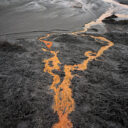
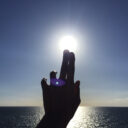

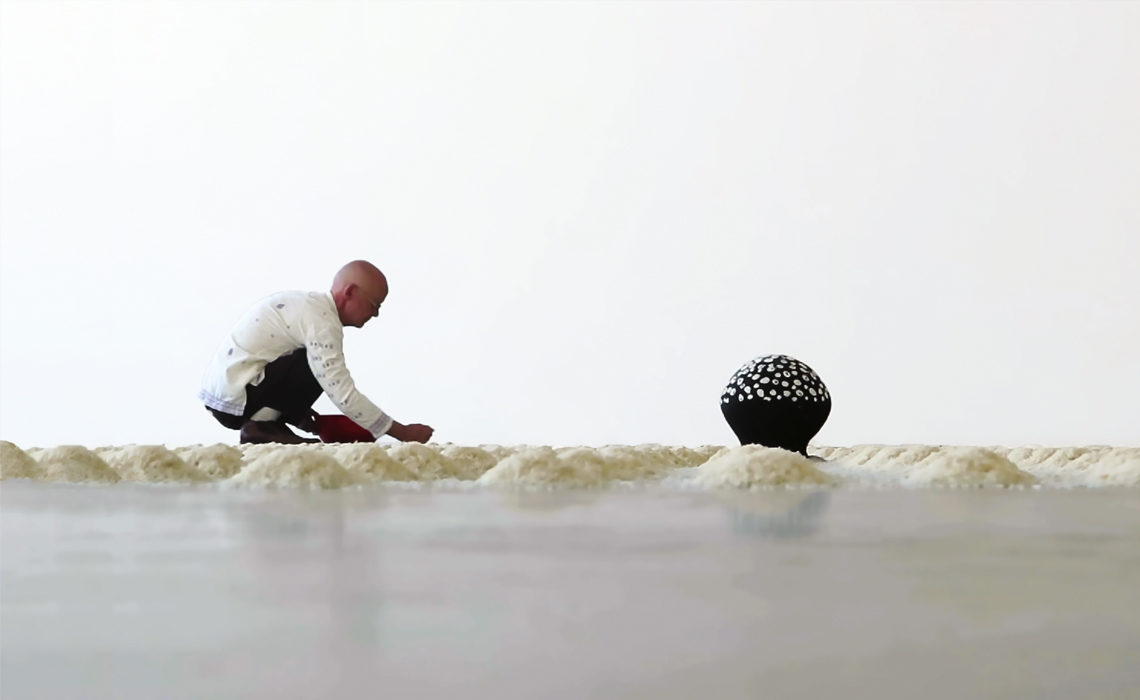
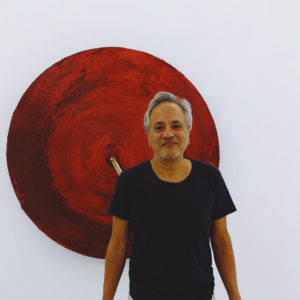
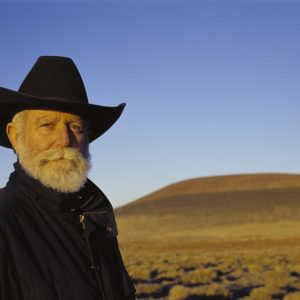
No Comments